The Japan Self-Defense Forces employ mostly outdated, Cold War-era weaponry and equipment in the Special Region, given the low threat level of low-tech foes such as the Empire, preferring to keep their most advanced weapons in Japan to defend against potential threats on Earth. Furthermore, another reason for the JSDF to deploy outdated military hardware in the Special Region is to save cost since the cost of manufacturing modern standard military hardware as well as repairing damaged standard modern equipment is very expensive so they rather using weapons that are dusted in the storage to deal with the threat in the Special Region. However, some more advanced weapon are used in the Special Region, presumably due to reliability issues of their older counterparts. Below is a list of all firearms, ammunition, and vehicles seen in the anime, novel, and manga series.
Blade
Combat knife
M1 Bayonet
The standard bayonet used by the JSDF. It is attached to the end of the Howa Type 64 rifles.
Bow
Compound bow
Handgun
Nambu Model 60
A .38 caliber, 5-shot police revolver used by Tokyo Police officers during the Battle of Ginza.
Minebea P-9
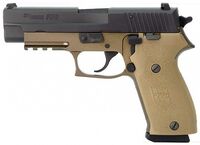
Weapon
Standard issue sidearm of the JSDF, 9mm handgun with a nine-round magazine. Used by Shino Kuribayashi during the Battle of Italica. Yurata in Episode 16 is also seen with one as a concealed carry.
M1911 pistol
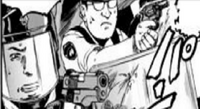
Weapon
The M1911 is a single-action, semi-automatic, magazine-fed, recoil-operated pistol chambered for the .45 ACP cartridge.[1] It served as the standard-issue sidearm for the United States Armed Forces from 1911 to 1986. It was first used in later stages of the Philippine–American War, and was widely used in World War I, World War II, the Korean War, and the Vietnam War. The pistol's formal designation as of 1940 was Automatic Pistol, Caliber .45, M1911 for the original model of 1911 or Automatic Pistol, Caliber .45, M1911A1 for the M1911A1, adopted in 1924. The designation changed to Pistol, Caliber .45, Automatic, M1911A1 in the Vietnam War era. A police office in the Tokyo Police Force uses the M1911 to shoot at the Imperial Soldier during the Battle of Ginza.
Springfield Armory XDM
Makarov PM
One of the Russian operatives at the Hakone Incident carries a Russian-made Makarov PM 9mm handgun. Interestingly, he carries the Makarov rather than a more modern Russian handgun such as the MP-443 Grach or Gsh-18, which would typically be used by special forces.
Shotgun
KSG
This shotgun was used by the CIA member Roger during the Hakone Incident, it's also used by the Special Forces Group at the Skirmish at Akusho, may be it's one of the KSG scavenged from Hakone Incident.
Saw-off Shotgun
Submachine gun
MP7
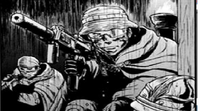
Weapon
A German-made 4.6mm submachine gun firing micro-rifle rounds with greater stopping power than used pistol caliber rounds used by most SMGs. Used by foreign black-ops forces during the Hakone Incident and later looted by Third Recon Team. MP7s are also used by JSDF forces in the Special Region.
Uzi
A 9mm submachine gun introduced into the Israelian army in 1954. Some members of the JSDF's Special Force carry Uzis with silencer attachments.
MP5
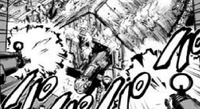
Weapon
The Heckler & Koch MP5 (from German: Maschinenpistole 5, meaning Submachine gun 5) is a 9mm submachine gun of German design, developed in the 1960s by a team of engineers from the German small arms manufacturer Heckler & Koch GmbH (H&K) of Oberndorf am Neckar. There are over 100 variants of the MP5,[3] including some semi-automatic versions. The MP5 is one of the most widely used submachine guns in the world,[4] having been adopted by 40 nations and numerous military, law enforcement, intelligence, and security organizations.[2] It is widely used by SWAT teams in North America. It is shown to be used by Tokyo PD during the Battle of Ginza to shoot at Imperial Soldiers and Battering Ram.
Skorpion Vz. 61
Russian operatives in the anime version of the Hakone Incident carry suppressed Czech-made Skorpion 7.65mm submachine guns.
Kriss Vector
The KRISS Vector series are a family of weapons based upon the parent submachine gun design developed by KRISS USA, formerly Transformational Defense Industries (TDI). They use an unconventional delayed blowback system combined with in-line design to reduce perceived recoil and muzzle climb. A member of the Chinese special force carries this weapon during the Hakone Incident.
Smith & Wesson M76
The Smith & Wesson M76 submachine gun was produced by Smith & Wesson from 1967 to 1974. It is a copy of the Swedish Carl Gustav m/45 with an open bolt design and fires 9x19mm Parabellum ammunition. During the Hakone Incident, some Chinese MSS agents carries these gun
Personal defense weapon
FN P90
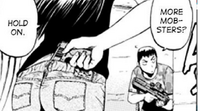
Weapon
The FN P90, also known as the FN Project 1990, is a personal defense weapon (PDW) designed and manufactured by FN Herstal in Belgium. Created in response to NATO requests for a replacement for 9×19mm Parabellum firearms, the P90 was designed as a compact but powerful firearm for vehicle crews, operators of crew-served weapons, support personnel, special forces, and counter-terrorist groups. During the Oprichnina attacks on the Jade Palace, some JSDF personnel carries these gun to protect the Japanese envoy from inside the building. Furthermore, during the earthquake in the Special Region, one JSDF member carries this gun in the JSDF safe house in Akutsho.
Magpul PDR
The Magpul PDR or Personal Defense Rifle, is a US-made ultra-compact 5.56mm personal defense weapon and carbine seen in the hands of the CIA special forces at the Hakone Incident. The weapon is later looted off a fallen soldier by Shino Kuribayashi.
Knight's Armament PDW
The KAC PDW (Personal Defense Weapon) is a weapon of US origin, firing a 6x35mm cartridge. At least one CIA agent at the Hakone Incident is equipped with one in the manga, and it is featured more prominently in the anime as being issued to the whole CIA team.
Carbine
M4 Carbine
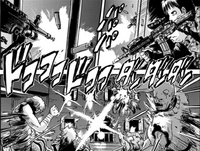
Weapon
CIA personnel at the Hakone Incident carry 5.56mm M4 Carbines, standard issue carbine of the US military. The M4s used by the CIA paramilitary personnel are equipped with suppressors and Aim Point-style holographic red dot sights. In the manga, Akira Tomita scavenges one off a fallen CIA soldier. It is used by JSDF soldiers at Skirmish at Akusho.
Assault rifle
QBZ-95
Heckler & Koch HK416
The Heckler & Koch HK416 (HK M4, German M4 Carbine) is an assault rifle and carbine designed and manufactured by Heckler & Koch. It is based on the AR-15 platform. JSDF special forces are seen using the weapon at the Hakone Incident. The HK417, a variant chambered in 7.62, is used by the SFG in the anime.
Howa Type 89
The Howa Type 89 is a 5.56mm assault rifle which replaced the older Type 64. Not initially seen in the Special Region, the Type 89 was, however, used by JSDF forces during the Battle of Ginza. The Type 89 saw its first use in the Special Region in the hands of JSDF paratroopers during the JSDF intervention in the Siege of the Jade Palace
FN SCAR
The FN SCAR is an assault rifle available in 5.56mm (SCAR-L) and 7.62mm (SCAR-H) made by Belgian firm Fabrique Nationale (FN) and used by US Special Forces. The weapon is seen in the hands of CIA personnel at the Hakone Incident in the manga. One of the CIA personnel manage to lightly wound Rory Mercury with the weapon. However, she regenerates almost immediately afterwards.
Battle rifle
Howa Type 64

Weapon
The Howa Type 64 is a 7.62mm battle rifle used during the Cold War, now a reserve weapon supplanted by the Howa Type 89. In the Special Region, this is the standard JSDF rifle. After being reassigned to a resource survey team, Yōji Itami is issued a Type 64 with a low-power scope.
Heckler & Koch HK417
The Heckler & Koch HK417 is a battle rifle designed and manufactured by Heckler & Koch in Germany. It is a gas-operated, selective fire rifle with a rotating bolt. It's chambered for the full-power 7.62×51mm NATO round, instead of the less powerful 5.56×45mm NATO intermediate cartridge. The HK417 is intended for use in roles where the greater penetrative power and range of the 7.62×51mm NATO round are required. It has been adopted for service by a number of armed forces, special forces, and police organizations. Several members of the JSDF Special Forces uses these rifle during the Hakone Incident and the rescue operation of the Japan diplomats and pro-peace senator
Sniper rifle
Barrett M82
M24 Sniper Weapon System
The M24 Sniper Weapons System is the standard issue sniper rifle for the US Army and the Japanese Self-Defense Forces. The weapon is a military version of the Remington 700 bolt-action rifle equipped with a 10x Leupold Scope as standard. The weapon used by the Special Forces Group at the Hakone Incident and the Skirmish at Akusho had a suppressor attached the barrel.
Machine gun
Variant
- Light machine gun
- General-purpose machine gun
- Squad automatic weapon
- Medium machine gun
- Heavy machine gun
Sumitomo Type 62
Sumitomo Type 74
A Sumitomo Type 74 machine gun is used on Fuji-made UH-1 Hueys. Most of these machine guns are mounted on attack helicopter.
Sumitomo Minimi
The Sumitomo Minimi, known in US service as the M249 SAW or Squad Automatic Weapon is a belt-fed 5.56mm light machine gun used for squad support by the United States military, Japan Self-Defense Forces, and many other militaries worldwide. The weapon is renowned for its light weight and rapid rate of fire, allowing it to lay down fire support while keeping up with squads of infantry on the move.
Sumitomo NTK-62
The Sumitomo NTK-62 (62式7.62mm機関銃 Rokuni-shiki Nana-ten-rokuni-miri Kikanjū) is the standard issue General-purpose machine gun (GPMG) of the Japan Self-Defense Forces, known as the Type 62 GPMG. Though the Sumitomo Heavy Industries' M249 has largely replaced it in the JGSDF,[6][7] the weapon still plays a support role as it is still used as a co-axial weapon in various armored vehicles, including tanks and APCs, as well as being a medium support machine gun. Due to being prone to malfunction, the gun is not used in the Special Region.
M2 Browning
The M2 Browning was created John Browning at the end of World War I and has been in service since 1933 up to the present due to its high versatility and fire power. It is the primary heavy machine gun of NATO countries and its use in the JGSDF (license produced by Sumitomo) is no different. It fires 12.7mm rounds, which are highly effective against most enemies the JSDF encounters in the Special Region. 12.7mm caliber rounds can be used against vehicles, lightly armored aircraft, and non-fortified buildings; making it ideal for use against thin armored shields and armor worn by soldier's of the Empire. The M2 is also capable of taking down smaller dragons with sustained fire, but is entirely ineffective against an ancient Flame Dragon, save for lucky shots against the eyes.
Browning M1919A4
The M1919 Browning is a .30 caliber medium machine gun that was widely used during the 20th century, especially during World War II, the Korean War, and the Vietnam War. The M1919 saw service as a light infantry, coaxial, mounted, aircraft, and anti-aircraft machine gun by the U.S. and many other countries. Many M1919s were rechambered for the new 7.62×51mm NATO round and remain in service to this day. Most of these machine gun is mounted in armored vehicles.
Autocannon
Variant
Variants include the various types of multi-barrel machine guns and the rotary cannon.
Railgun
M197 Vulcan
The M197 electric cannon is a three-barreled electric Gatling-type rotary cannon used by the United States military and JSDF. The M197 Vulcan often seen mounted in the attack helicopters.
M61 Vulcan
The M61 Vulcan is a hydraulically or pneumatically driven, six-barrel, air-cooled, electrically fired Gatling-style rotary cannon which fires 20 mm rounds at an extremely high rate (typically 6,000 rounds per minute). The M61 and its derivatives have been the principal cannon armament of United States military fixed-wing aircraft for 50 years. F-4 Phantom is installed with M61 Vulcan.
Less-lethal
Net gun
Riot gun
Water Cannon
Uniform
Type III Flecktarn Camouflage
Type III Flecktarn (German: mottled camouflage) is the standard camouflage pattern and uniform of the JGSDF and was adopted into service in 2007. It only approves upon the Type II version by changing pockets, ergonomics, and minor changes, leaving the camouflage virtually the same as the Type II.
Type IV Flecktarn Camouflage
Type IV Flecktarn is a fictional camouflage that was being pushed into service just as the Gate opened up. It appears to remove any brown that the Type III had, and just used shades of olive green. The Camo also appears to have been hand designed, as shown by the circular designs and melting of colors typically seen in hand designed camos. Digital camos are made from small rectangles and appear very boxy when in close proximity, but work better at a distance compared to the hand drawn irregular smooth shapes drawn by hand.
Body Armor
Riot gear
Type II Body Armor
The Type II Body Armor was created due to the need for a new body armor with quick release function for the JGSDF's upcoming deployment to Iraq in 2004. The body armor can take SAPI plates like their American counterparts, but can also be used without them. The body armor has an NIJ Level III - A protection level that can stop most pistol calibers but falls short, unable to stop most rifle calibers, which most soldiers would end up facing against. The user also puts on the body armor like one would with a jacket, which means that a SAPI plate could not be inserted until a user puts the body armor on. The Type II Body Armor was used by most JGSDF personnel while in the Special Region probably due to lack of firearms and trend of using outdated equipment.
Type III Body Armor
Type III Body armor is the latest body armor in the JSDF's arsenal. It employs many of the contemporary parts of other body armor's like a SAPI plate that is always inserted and the armor has to be pulled over the user's head. It lacks side armor plates like the US military's IOTV body armor system. The system also has a quick release, and an unseen before feature in JSDF body armor of a large cervical guard and shoulder pads. SAPI plates make the body armor have a NIJ Level III, which is capable of stopping most rifle calibers like 5.56 mm and 7.62 mm.
Explosive
Armour-piercing fin-stabilized discarding sabot
RPG-7
Panzerfaust-3

Weapon
License built by IHI Aerospace in Japan, the Panzerfaust-3 is a German-designed rocket launcher firing a 110mm rocket. The weapon can fire both armor-piercing shaped charge warheads for use against tanks and other armored vehicles, or high explosive rockets for use against fortifications and soft targets. The weapon proves itself to be capable of penetrating the scales of the Flame Dragon.
Flamethrower
Type 53 Flare Gun
M203 grenade launcher
BGM-71 TOW
The BGM-71 TOW (Tube-launched, Optically tracked, Wire-guided or Wireless)[6] is an American anti-tank missile. TOW replaced much smaller missiles like the SS.10 and ENTAC, offering roughly twice the effective range, a more powerful warhead, and a greatly improved semi-automatic guidance system that could also be equipped with infrared cameras for night time use. The BGM-71 TOW is used by JGSDF AH-1S Cobra gunships.
Smoke Grenade
Stun grenade
M26 grenade
The M26 fragmentation grenade was the predecessor to the M67, used by US forces during the Korean and Vietnam War. An M26, likely reserve stock, is used by Yōji Itami to kill a group of Crety Epidemic zombies in chapter 50.
M67 Fragmentation Grenade
The M67 is a fragmentation hand grenade used by the US and other military forces worldwide. The weapon has a Composition B. charge and a casualty radius of 15 meters. The grenade is used by the JSDF in the Special Region, most notably by Shino Kuribayashi during the Battle of Italica. During the same battle, the grenades were dropped by JSDF troops from from UH-1 helicopters onto attacking bandit forces.
Type 06 rifle grenade
The Type 06 rifle grenade (06式小銃てき弾 Maru-roku-shiki Shōjū Tekidan) is a rifle grenade used by the JGSDF. It can be launched from the Howa Type 89 or Howa Type 64 rifles without other attachments. Some members of the paratrooper squad used the rifle grenade to kill dozens of Imperial Soldiers during the rescue operation of Japanese diplomat and pro-peace senators.
Detonating cord
C4
C-4 or Composition C-4 is a common variety of the plastic explosive family known as Composition C. Itami uses dozens pack of C4 to kill the Flame Dragon.
Laser Joint Direct Attack Munition
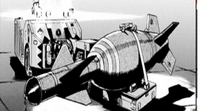
Manga JDAM
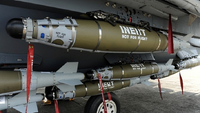
Real life Inert JDAM
The Laser Joint Direct Attack Munition (LJDAM) is a kit attached to conventional ammunition to make them more accurate and possible to guide thanks to the attached fins and stabilizers. It has a camera on the front tip that is used to guide the bomb in by laser. The smart bomb is used to bomb the Senate (feature in the picture).
Illumination shell
Napalm
Napalm is a flammable liquid used in warfare. It is a mixture of a gelling agent and either gasoline (petrol) or a similar fuel. It was initially used as an incendiary device against buildings and later primarily as an anti-personnel weapon, as it sticks to skin and causes severe burns when on fire. This compound is used to burn Zorzal's force guerrilla position during the Civil War and monster ambushes. The weapon earns great fears among Zorzal's generals and soldiers as well as Special Region in general due to its burning effect on human body and monster alike in which it cannot be extinguished with water.
L16 Mortar
The United Kingdom's L16 81 mm mortar is the standard mortar used by the British armed forces. It originated as a joint design by the UK and Canada. The version produced and used by Australia is named the F2 81mm Mortar, whilst the version used by the U.S. armed forces is known as the M252.
M18 Claymore mine
The M18A1 Claymore is a directional anti-personnel mine developed for the United States Armed Forces.The Claymore fires steel balls, out to about 100 m (110 yd) within a 60° arc in front of the device. It is used primarily in ambushesand as an anti-infiltration device against enemy infantry. It is also used against unarmored vehicles. During the Raid on the South Palace, JSDF Special Force used claymore mine to kill pursuing cavalry troops to ensure the Third Recon Team succeed in rescuing Pina and Emperor Molt.
Light Vehicle
Toyota High Mobility Vehicle
The Toyota High Mobility Vehicle, or HMV is a military version of the Toyota Mega Cruiser, and is similar in appearance to the American HMMWV or Humvee. The vehicle is intended as a light all terrain patrol vehicle and light transport, and can be armed with various machine guns and anti-tank missiles.
Mitsubishi Type 73 light truck
The Mitsubishi Type 73 light truck is a multirole LAV used by the JGSDF for reconnaissance and carrying equipment and men. It can also be armed with a mounted M2 Browning for more fire power to support a fireteam and lay down suppressing fire. The design of the Type 73 closely resembles the mass produced Willy Jeep that were brought in large number to Japan after World War II by American occupational forces.
Komatsu LAV
The Komatsu LAV is a light armored vehicle that has been in service since 2002, boasting 1855 produced since its inception. It can hold up 4+1 crew members counting a MG or ATGM gunner.
Honda XLR250R Reconnaissance Motorcycle
First introduced by Honda in 1972, the XLR250R is a 4 stroke enduro motorcycle and the first mass produced 4-valve motorcycle. It acts as a lightweight recon vehicle ahead of the main force. It seats one man.
Armored Vehicle
Type 73 Armored Personnel Carrier
The Type 73 is a Cold War-era armored personnel carrier used in reserve JSDF service, and was, like many older JSDF materiel, was deployed to the Special Region. The APC carries an M2 Browning .50 caliber machine gun and a secondary M1919 .30 caliber machine gun. The vehicle was superseded by the Type 89 infantry fighting vehicle.
Type 87 Armored Reconnaissance Vehicle
The six wheeled armored recon vehicle, the Type 87, was developed at the end of the 1970s. It can hold a crew of 5. The vehicle carries a 25mm automatic cannon and a 7.62mm machine gun, giving it the capability to engage light armored vehicles and infantry.
Special Terrain Type 74
The Mitsubishi Type-74, also known as the nana-yon, was the main battle tank of the Japan Self-Defense Forces starting in 1975, but was supplanted by the more modern Mitsubishi Type 90 in 1990 and the Type 10 in 2012. While outdated by modern standards, the tank is still in reserve service and is the primary tank sent the Special Region, where it proves devastating against the primitive armies of the Empire during the Second Battle of Alnus Hill. The Special Terrain variant used in the Special Region has been upgraded with US-provided TUSKs (Tank Urban Survival Kits), as well as armored track skirts. The tank is armed with a 105mm main gun and two machine guns, one M2 Browning .50 caliber machine gun and one 7.62mm machine gun.
Type 75 155 mm Self-Propelled Howitzer
The Type 75 155 mm self-propelled howitzer (75式自走155mm榴弾砲 nana-go-shiki-jisou-115mm-ryuudan-hou) is an older 1st generation armored artillery vehicle. It holds a crew of five.
Type 87 Self-Propelled Anti-Aircraft Gun
The Type 87 SPAAG is a Cold War-era mobile anti-aircraft platform armed with two 35mm automatic cannons. While it is still in reserve service, the vehicle is generally considered obsolete, superseded by more modern surface-to-air missile systems. The vehicle found new use in the Special Region, where its autocannons proved deadly against Dragons and foot soldiers alike at the Second Battle of Alnus Hill.
M42 Duster
The M42 40 mm Self-Propelled Anti-Aircraft Gun, or Duster, is an American armored light air-defense gun built for the United States Army from 1952 until December 1960, in service until 1988. Production of this vehicle was performed by the tank division of the General Motors Corporation. It used components from the M41 light tank and was constructed of all-welded steel. During the Second Battle of Alnus Hill, the JSDF used this vehicle along with Type 87 to shoot down dragon troop from the Allied army.
Type 96 Armored Personnel Carrier
The Type 96 Armored personnel carrier was first produced in 1995; the JGSDF operates 340 of these vehicles, as of 2012. It can hold 2+8 soldiers. It is armed with an M2 .50 caliber machine gun and 40mm grenade launcher.
Type 16 Maneuver Combat Vehicle
The Type 16 Maneuver Combat Vehicle (16式機動戦闘車 Hitoroku-shiki kidou-sentou-sha) is a wheeled tank destroyer of the Japan Ground Self-Defense Force introduces in 2013 armed with a 105mm main gun and a 7.62mm and .50 caliber machine gun. The vehicle is designed to act as a fast, mobile anti-tank and armored support vehicle. The vehicle is lightly armored, but more mobile than a tank, and can be transported by air. At least one MCV responded to the appearance of the gate, and participated in the Battle of Ginza (only seen in the anime). MCVs, like most newer weapons in the JSDF arsenal, were not deployed to the Special Region.
Mitsubishi Type 90 Main Battle Tank
The Mitsubishi Type 90 (90式戦車 Kyū-maru-shiki-sensha?), or the Kyū-maru, is a main battle tank designed in the 1980s and adopted by the JSDF in 1990, manufactured by Mitsubishi Heavy Industries. The tank is roughly comparable to other modern main battle tanks such as the American M1 Abrams, British Challenger, and German Leopard, and is armored with composite armor, and armed with a Rheinmetall 120mm L44 main gun, as well as an M2 Browning machine gun and a 7.62mm co-axial machine gun. At least two Type 90s are depicted as engaging Imperial forces during the Battle of Ginza as shown in chapter 48 of the manga.
Mitsubishi Type-10 Main Battle Tank
The Mitsubishi Type-10 Main Battle Tank is the most advanced main battle tank in service with the JSDF, which was first ordered in 2009 and was first deployed in 2012. The tank has a number of improvements over the Type-90, including modular armor to modify it for a variety of missions, as well as a Japanese-made 120mm main gun capable of firing a new type of discarding sabot ammunition with superior performance over previous models, as well as more advanced electronics. The tank is also armed with a Browning M2 machine gun and a co-axial 7.62mm machine gun. At least one Type 10 participated in the Battle of Ginza as depicted in chapter 48 of the manga.
Type 60 Self-propelled 106 mm Recoilless Gun
The Type 60 Self-propelled 106 mm Recoilless Gun (60式自走無反動砲 roku-maru-shiki-jisou-muhandou-hou) is a light anti-tank vehicle developed by Japan in the late 1950s. It mounts two M40 106 mm recoilless rifles as its main armament. The vehicle is often used by the JSDF to kill Orge, Black Dogs, War Elephant and Rhinos.
Support Vehicle
Type 70 Self-Propelled Floating Bridge
The Type 70 Self-Propelled Floating Bridge is a utility vehicle used by the JSDF to move heavy vehicles and equipment across a river. Multiple Type 70s can be attached to each other to create a larger platform or actually create a bridge across a river.
Excavator
An excavator is a tracked vehicle equipped with a bucket mounted on an arm for digging holes, commonly used on construction sites. JSDF engineers used excavators in the construction of the base at Alnus.
Helicopter
Chinook
AH-1S Cobra Attack Helicopter
First used by the United States in the Vietnam, the AH-1S Cobra Attack Helicopter is an improved version of the AH-1Q, the first generation Cobra. In JSDF service, the Cobra carries eight TOW anti-tank missiles, two rocket pods, and a 20mm nose-mounted Gatling gun. Cobra gunships were among the forces which participated in the Battle of Ginza, and were part of the air support which won the Battle of Italica for the Third Recon Team and their Special Region allies. Cobra gunships also fired anti-tank missiles, killing two juvenile Flame Dragons alongside F-4 Phantoms and artillery.
CH-47JA
The CH-47JA is a custom built CH-47J for the JGSDF, introduced in 1993; long-ranged version of the CH-47J. The only differences between the CH-47J and the CH-47D are the engine, rotor brake, and avionics. It can hold up to 3+55 crew members or up to 12.7 tons worth of cargo.
UH-1J Multi-purpose Helicopter
UH-1J is the go-to multi-purpose helicopter of the JASDF. Used as an infantry carrier, assault helicopter, and light transport. This helicopter is used extensively by all branches of the JSDF. For assault duties, the helicopter can be equipped with two door-mounted M2 Browning machine guns. During the Battle of Italica, these gun mounts allowed it to be used as a light gunship, strafing Imperial troops.
OH-6 Light Helicopter
The OH-6 Cayuse, also known by its nickname of Loach is a military version of the MD-500 lightweight helicopter in US military service since 1966 and is also operated by the Japan Self-Defense Forces. The helicopter is used primarily as an observation helicopter, but can light attack and personnel transport variants also exist.
Kawasaki OH-1
The Kawasaki OH-1 Ninja is a JSDF reconnaissance and observation helicopter designed to the replace the aging OH-6, introduced in 1998. The helicopter carries four Type-91 air-to-air missiles for self-defense and anti-helicopter missions. The OH-1 was deployed at the Battle of Italica, spotting targets for AH-1S Cobra Attack Helicopters.
AH-64DJP Apache Helicopter Gunship
The AH-64 Apache Helicopter Gunship is an anti-tank attack helicopter developed in the late 1970s and early 1980s. Apaches were first deployed by the JSDF in 2006. The Apache can be armed with up to 16 AGM-114 Hellfire anti-tank missiles, 76 Hydra 70mm rockets, four AIM-92 Stinger air-to-air missiles, and a 30mm chain gun. An Apache responded in the Battle of Ginza in the manga, but was not deployed in the Special Region.
V-22 Osprey
The V-22 Osprey is a tiltrotor transport aircraft capable of flying with rotors raised above the aircraft, like a helicopter, allowing it to hover and take off and land vertically, as well as in front of the wing, like acting as a propeller for forward flight. The V-22 is in service with the US Marine Corps and Air Force, and orders have also been made by the Japanese Self-Defense Forces.
Fixed-Wing Aircraft
F-4EJ Phantom II
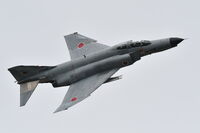
Weapon
The F-4 Phantom is a Cold War-era fighter aircraft which saw service with the United States in the Vietnam War. It was removed from service by the US military, but remains in Japanese Air Self Defense Force service. The aircraft can be armed with a variety of ordnance, including air-to-air missiles and laser-guided bombs. In the Special Region, the aircraft was used in a precision strike on the (then-evacuated) Imperial Senate orchestrated to intimidate the Empire into liberating any Japanese slaves taken early in the Battle of Ginza. F-4s also engaged the Flame Dragon, and, along with Cobra gunships and artillery, successfully shot down two of its offspring shortly after the dragon itself was slain by Yōji Itami, Rory Mercury, Lelei La Lelena, and Tuka Luna Marceau.
Mitsubishi MU-2
The Mitsubishi MU-2 is a twin-engine turboprop aircraft used for reconnaissance and search and rescue by the JSDF. The JSDF version, or LR-1 differs from the civilian model in that it has extra fuel capacity, a larger side door for deploying inflatable life rafts, larger windows for observation purposes, and improved radar equipment. At least one MU-2 used in the Special Region also has the non-standard modification of a door-mounted machine gun, possibly for use as a field expedient gunship.
Kawasaki C-1
The Kawasaki C-1 is heavy transport aircraft used by the Japanese Air Self Defense Forces, capable up to 15,380 kg of materiel. The aircraft is powered by two turbofan jet engines. A C-1 is seen flying above the Gate in chapter 46 of the manga in the Special Region. If C-1s are operating in the Special Region, they would presumably have to be dismantled and reassembled on the other side in order to fit through the Gate. Later in chapter 52, the C-1 rendevous with Yōji Itami, Rory Mercury, Lelei La Lelena, Tuka Luna Marceau, and Yao Haa Dushi to airdrop a package. The pilot of the plane informed Itami of a recent coup-d'etat that took place within the capital of the empire and that additional information regarding these events could be found in the package.
Drone
Northrop Grumman RQ-4 Global Hawk
The Northrop Grumman RQ-4 Global Hawk is an unmanned (UAV) surveillance aircraft. It was initially designed by Ryan Aeronautical (now part of Northrop Grumman), and known as Tier II+ during development. The Global Hawk performs a similar role as the Lockheed U-2. The RQ-4 provides a broad overview and systematic surveillance using high-resolution synthetic aperture radar (SAR) and long-range electro-optical/infrared (EO/IR) sensors with long loiter times over target areas. It can survey as much as 40,000 square miles (100,000 km2) of terrain a day. The JSDF is seen using Northrop Grumman RQ-4 Global Hawk drone to recon the retreating Imperial Troops during the Battle of Ginza.
Unmanned ground vehicle
The JSDF uses an unnamed model of recon UGV to recon the others sides of the Gate during the First Battle of Alnus Hill, which occurs after the Battle of Ginza.
Dji Phantom Pro
Dji Phantom Pro is a civillian drone used for by the JSDF for reconnaissance purpose. Due to the fact that the advanced Northrop Grumman RQ-4 Global Hawk cannot operate in the Special Region because of the lack of satellite infrastructure, this drone is used for its versatile since its only used antenna signal to control.
Asagiri-class Destroyer
An Asagiri-class destroyer of the Japanese Maritime Self-Defense Forces was mentioned as among the forces deployed in response to the Battle of Ginza. The vessel is not seen, however, it may have provided gun and missile support against Imperial targets. The Asagiri-class are armed with a variety of weapons, including 76mm cannon, 20mm Phalanx CIWS, Sea Sparrow surface-to-air missiles, Harpoon anti-ship missiles, torpedoes, and anti-submarine weapons.
Oyashio-class submarine
The Oyashio is a class of Japanese diesel-electric attack submarine operated by the JMSDF. The submarines entered service in the late 1990s. The submarines are larger than the earlier Harushio-class submarines, to provide space for a flank sonar array. During the event of Gate: Weight Anchor, Itami commands this type of submarine during his mission.
